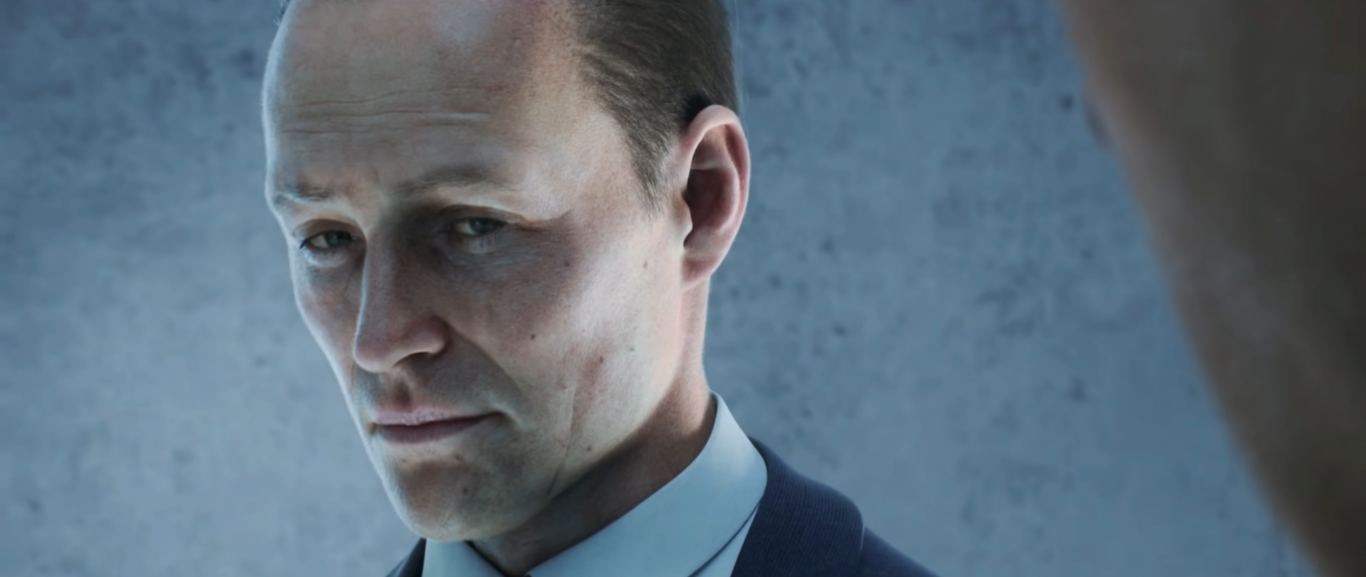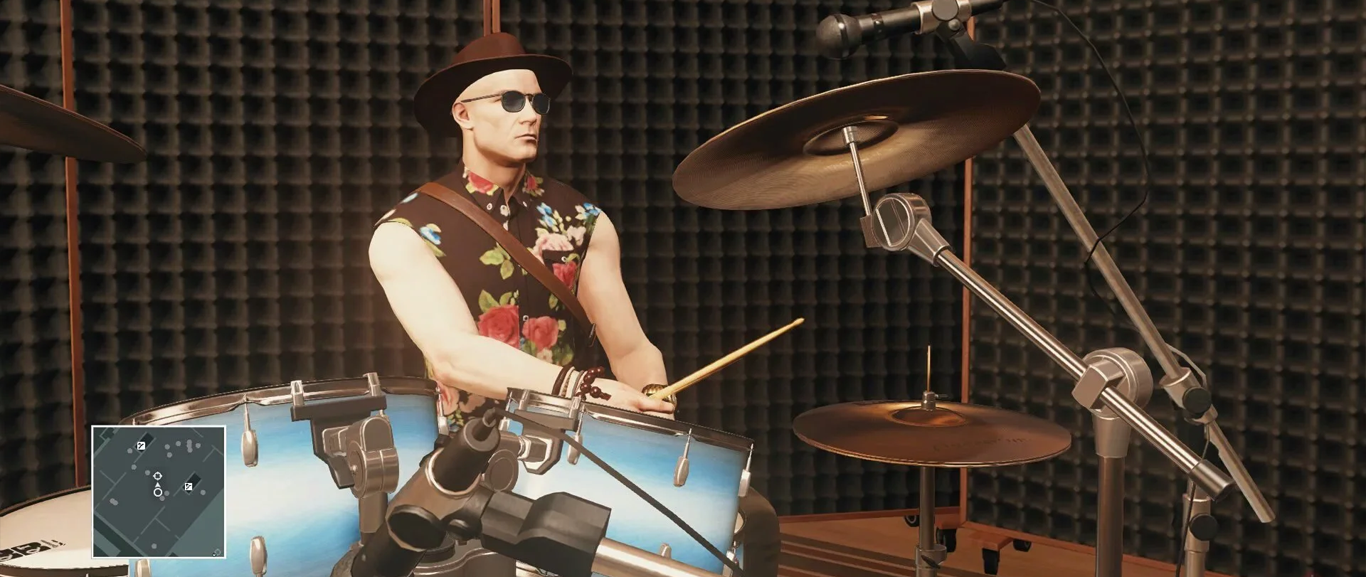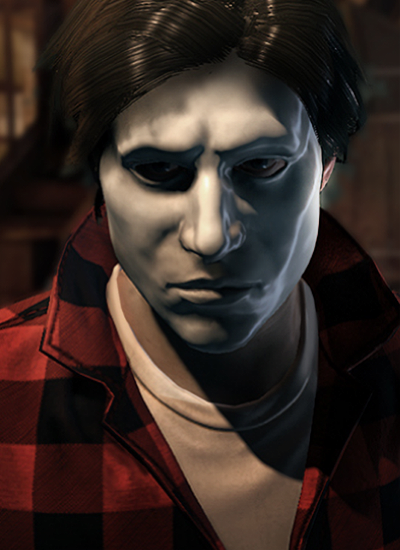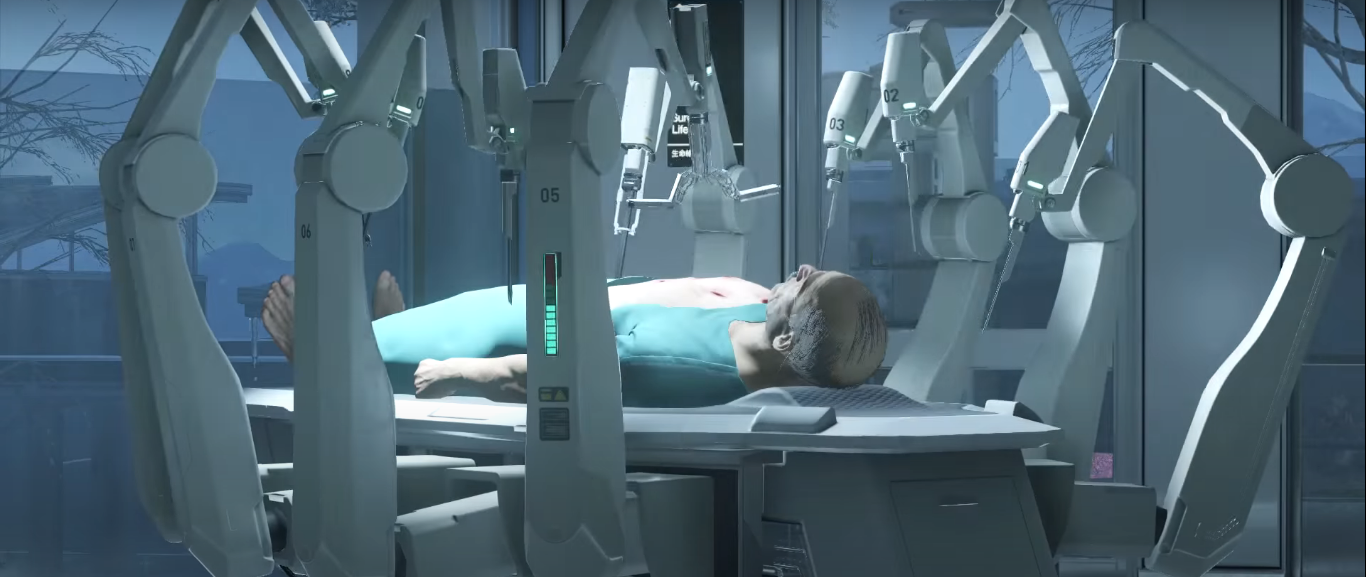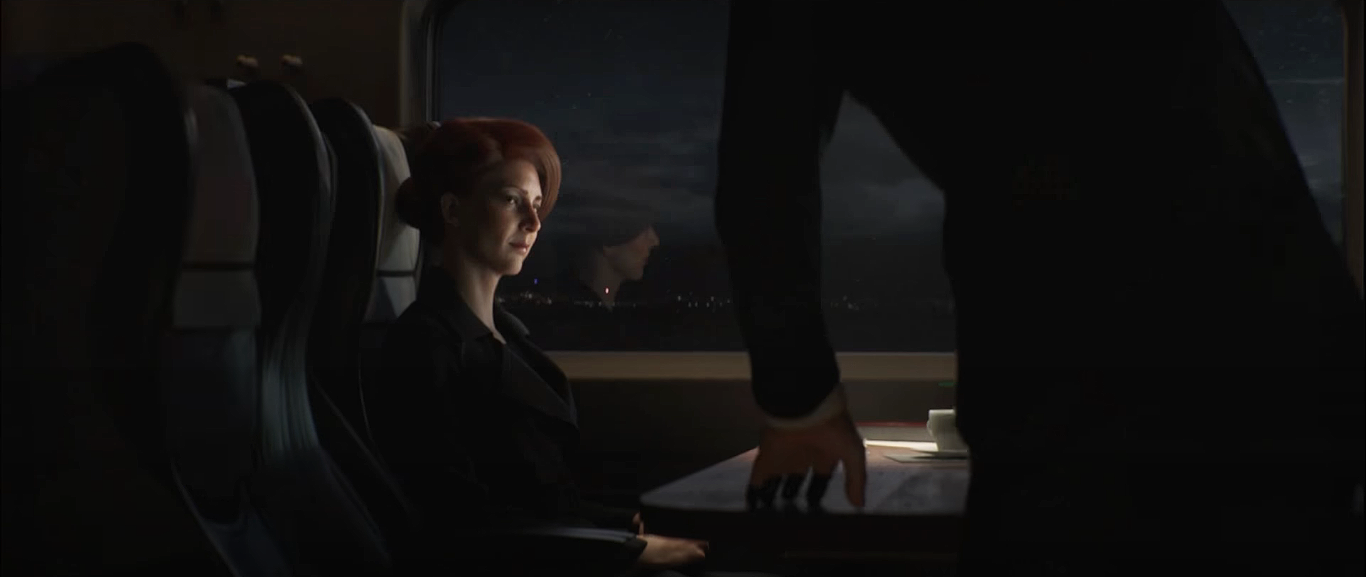
After saving MI6’s bacon, preventing viral mayhem, and nipping a coup in the bud, something’s starting to feel off. These assignments sound straightforward in Diana’s briefings, but once we touch down, we find that something more is going on. Someone has an ulterior motive, or knows something they shouldn’t, or is taking orders from a man behind a curtain. Meanwhile, a stranger in a coat has been moving through the background, meeting with Viktor and carrying out a hit of his own. It’s all very cryptic, and we don’t have much context for it yet. Like any good thriller, Hitman wants us to be patient.
We’ve also heard a particular name dropped twice now: Providence. We’re not sure who they are. We just know they have far-reaching influence. We’re on, what, the sixth Hitman game? We know where this is going. But so far, we’ve only seen a fin circling in the distance. After Marrakesh, a man who represents the group meets with a “Mr. Fanin,” a newly-appointed CEO. From the sound of things, they’re in big trouble. There’s been a data leak, and Fanin - as well as many others - may be openly linked to them. Why is this bad, exactly? We can’t tell yet. What we can tell is that this representative holds authority that he’s not afraid to use. How could such a soft-spoken, outwardly-unassuming man appear to strike terror into a banking executive? Where are the scars, like previous Hitman villains? The outlandish suit? This guy couldn’t be a threat. He looks too ordinary. Right?
We’ll see.

Now that we’ve been playing war games, our fourth job feels almost pedestrian. We’re off to Bangkok in pursuit of Jordan Cross, frontman of The Clash - I mean, The Class. Not long ago, the spoiled rock star pushed his girlfriend off a roof. One convenient acquittal later, he’s flown to the top of the charts. The girl’s parents, on the other hand, believe he escaped justice, and they want us to serve it to him on his 27th birthday. Seriously. No conspiracies or anything. (At least not for now. Hold that thought.) He’s just a garden-variety twerp who thought he was above the law. Still, it’s up to the Deadly Serious 47 to stay Cool Under Heat, take Complete Control, and leave before the guards know Somebody Got Murdered… fine, I’ll stop.
anyway here’s wonderwall
The Himmapan Hotel is so ornate that it’s easy to ignore the characters altogether and get lost in the scenery. Nonetheless, we’ve got work to do, and Jordan’s not our only priority. The Highmoores also want revenge on Ken Morgan, the lawyer who got him off. Ken is a Cambridge man transplanted to a New York power firm, and he steps out in a fusty blue-gray suit that straddles both influences. The thick pinstripes again evoke Wall Street, while the brown waistcoat attempts to make the suit three-piece, more popular with English wearers. Contrasting waistcoats can add visual interest, but they’re also a gamble. You have to coordinate the colors well, and it’s glaring when you don’t. Though it does technically match his shoes, it creates an earthy color palette that brings to mind stodginess, not slick modernity.
As a younger man, Ken might have been able to pull it off. But that was decades ago, and his accessories betray that he’s become set in his ways and comfortable with his success. For starters, he’s wearing a watch chain. Nobody uses pocket watches anymore. In the age of smartphone clocks, they’re a novelty at best, and at worst, a pretentious excuse to show off how wealthy you are. He’s also opted for a bow tie instead of a necktie, the go-to for physics professors in movies everywhere. (Funny how a bow tie looks nerdy with a daytime suit, but suave with a tuxedo. Context is everything!) We don’t really raise our eyebrows, though, because at his age and income bracket, Ken has moved beyond the need to appear fashionable. All a man in his position needs is to convey influence and experience. Anything more would be vanity.
Besides, it’s not like there’s a shortage of vanity when his client’s around. If Ken is a meat pie, Jordan is a vegan bacon donut. Nearly everything on him will be off-trend in ten years, from his man bun to his leg warmers and decorative dog tags. His top situation is particularly galling - a cuffed-up brocade blazer-slash-open dress shirt combo that’s going to age like milk. At least with other fashion trends that we now find silly, we can see how they played on certain notions of flattery. Breeches flaunted strong leg muscles. Codpieces, well, you know. What does Jordan’s outfit achieve? How does it show us his best side? Beats me.
Isn’t that the point, though? Aren’t rock stars supposed to wear outrageous outfits and challenge traditional behavior? In theory, sure. A lot of the aesthetics that we associate with counterculture musicians actually came from poverty. Hippies, coffee shop kids, and punks looked thirsty and miserable because they didn’t have any money, and needed to make, patch, or thrift their clothes. Over time, mainstream fashion commodified these aesthetics, and it became hip for rich kids to roleplay rebelliousness. There’s nothing DIY about Jordan Cross. His image is a careful construct, and while he seems to have genuine talent, we can’t say his music isn’t, too. And when faced with reality, he does the most poseur thing imaginable: call his billionaire dad to beg for a bailout.
But Jordan’s father stops picking up. His actions catch up to him. Little does he know that his father’s are about to, too. Thomas Cross is kidnapped and murdered at his son’s funeral, and that’s just too suspicious for the ICA to ignore. With that, Diana summons 47 to an airport to discuss their next move. All these contracts are the work of a shadow client, and it’s up to them to find out who.
This meeting brings 47 and Diana to the same space again, which a few games earlier would have been unthinkable. Remember all those rules about avoiding agent-handler contact? All the schemes Diana pulled to send 47 secret advice? Now, due to her seniority or a change in company culture, they can meet as colleagues, and that gives Diana a larger role in the narrative. In fifteen years, she’s gone from an email to a voice to a femme fatale to a source of angst to a deuteragonist. Guess girls really can have it all.
That means we get a fresh perspective on her, which means a fresh design, one that will define her ethos for the rest of the trilogy. Up top, Diana has a new hairstyle, a cross between a low bun and French twist. It’s elegant and evokes the Sixties, the golden age of espionage, and takes less than ten minutes once you have the muscle memory. She’s also dyed it again, suggesting that she still lives incognito, drifting between countries and identities. (Sorry, IOI. She’ll always be a natural brunette to me.) Below, she’s chosen a plain black day dress under a blue trench coat, leather gloves, and, of course, her signature ankle-straps. She looks neat, timeless, practical, and perfectly inconspicuous for a businesswoman. And where have we seen that theme before?
But Diana isn’t just taking a leaf out of 47’s book. All of her clothes are ingredients of the French capsule wardrobe. When people praise Parisian women’s effortless sense of style, the minimalist capsule look is usually what they have in mind. It involves buying a small set of basics - the specifics vary, but among other things, it may include a suit, a trench, a little black dress, a few pants, a few blouses, and one versatile pair of shoes. Because the items all match each other, you can remix them endlessly, creating a large number of outfits that cover every season and social setting. It fits in one suitcase, and for a woman with Diana’s lifestyle, the portability that it offers would be paramount. She needs to be able to pack up and vanish and still look good, which lends itself to a wardrobe that - like 47’s suit - travels well.

There’s always something awkward about 47 in rural America. He just feels like a fish out of water. I can’t put my finger on why. Maybe it’s his Continental aura. Maybe even his casual clothes seem too well-looked-after for the rugged atmosphere. So when he arrives in Colorado to put down the leaders of the shadow client’s private militia, he’ll have his work cut out for him. The insular group is well-hidden, well-acquainted, and well-armed, making them hostile to all starting suits - even the one he enters the level with. So much for 47 having an outfit for every occasion. We’re in prepper country now, and every new face is an enemy.
That leaves the player two options. We can either brave the whole farm without being seen, or raid the militiamen for their flak jackets and cargo pants. Everyone but the cook and the hackers are fully kitted out, which seems a little much for doing drills out in the wilderness. The elite members wear a variety of beanies, berets, pouches, and boots, all in olives and grays, which adds paramilitary sameness. The point man and spec ops guards take it even further: hoods, body armor, and a helmet that looks like it’d filter tear gas. You’d think they wouldn’t have anyone to impress out there, yet they hang onto the survivalist commando aesthetic with zeal.
Earlier, I mentioned that General Zaydan’s uniform was a rhetorical tool. The militia’s garb makes a statement of strength, too. The question is, for whom? They’re off-the-grid. No one’s supposed to see them. They could easily put the same tactical gear on over everyday clothes. But they don’t, because like many of these movements, the sameness of dress and thought is as much about keeping the ingroup loyal as they are keeping the outgroup out. In their matching outfits, the militiamen feel part of something bigger than themselves - tough, important, soldiers in a worthy war. They came to the militia from a wide variety of backgrounds, and if they’re not fully sold on the cause yet, it helps extinguish doubt. The militia will ask them to risk their lives. For that, they need to offer something in return, like camaraderie, a sense of belonging, and a goal to aspire to.
That means it’s up to the group’s authorities, Sean Rose and Maya Parvati, to set the marching tempo. Though we have four lieutenants to kill, it’s really Sean’s group, and it shows. His gear and green scarf match his militia’s aesthetic to a tee. Maya, however, was a Tamil Tiger before she joined, and it’s implied that she’s only around because she can’t fight anymore. Her lipstick, denim vest, Nataraja pendant, and baseball cap add personal touches that her more conformist charges lack. The real interest comes from her choice of prosthetic arm - a carbon-fiber split-hook, as utilitarian as they come. These days, she could’ve picked from a wide variety of styles, but she forgoes cosmetics altogether in favor of enhanced mobility. Maya has seen more action than many of her snot-nosed trainees ever will, and when push comes to shove, she’ll pick survival over fitting in.
Unfortunately, at the other end of the compound, we find a lieutenant who’s doing a pretty poor job of both. Penelope Graves, the group’s tactical chief, is no terrorist. She led the hunt against Sean when she was with Interpol. What’s she doing here? People both in and out of the game find her motives baffling, and her design suggests that she’s not what we might call a “culture fit.” Her quilted puffer jacket is far too city-girl for this crowd - she’s not only out of place, she’s in over her head. Whatever brought Penelope to the militia wounded her idealism, and her file suggests that in a different world, we might have recruited her. But our client got to us first, and 47 never turns down a job. She also has the dubious honor of one of the trilogy’s most gruesome kills. Poor thing.
And then there’s Ezra Berg. The militia’s interrogator seems to have taken to the whole “plotting murder out in the woods” thing well. He swerves away from their brand entirely, donning a buffalo plaid jacket that echoes Brando in On the Waterfront and the Shatner mask from Halloween. Though he uses the mask to terrify his drugged-up captives, we’re told he’s otherwise nonviolent. From his outfit choices, it looks like he’s a movie buff, too. I guess when you hole up in your torture basement all day, you get to do your own thing. In fact, let’s - yeah, let’s leave him to it. Back out of the room.

What 47 discovers in the shadow client’s lair drops a bigger bomb than the militia ever could. Not only was our Providence theory correct, we’re in trouble as well. Erich Soders, our boss, has defected to them to save himself. See, Soders’ ticker is going, and because his organs are reversed, he needs the kind of fast, rare transplant that only Providence can provide. He’s since absconded to GAMA, an ultra-exclusive hospital on the slopes of Hokkaido, where the surgery will take place. And what as he promised in return? A list of active ICA agents. Remember Paris? When powerful men are cornered, loyalty is cheap.
The eerie, tranquil beauty of GAMA - if you ask me, it’s one of the trilogy’s prettiest levels - belies its organ trafficking and experimental procedures. But like any good hospital, they’ll take your insurance. Providence has accepted Erich’s deal, so they’ve sent a liaison, lawyer Yuki Yamazaki, for the hand-off. Since she might access the ICA’s records, she’s gotta go, too. Unlike Ken Morgan, she presents a tangible threat. From her dark makeup to her yoga outfit that evokes a karate gi, Yuki announces that she’s not someone to be trifled with. Her edgy bob recalls shark fins, a common symbol of aggressive lawyers, and she wears a necklace with an origami bird, the Providence symbol. Unlike the Sapienza and Marrakesh targets, Yuki doesn’t hide her allegiance to the group. If anyone has a problem with it, she’s not afraid to handle it.
Her tattoo tells us why. Yuki’s top reveals an irezumi half-sleeve, a style that instantly identifies her as yakuza. The ancient Japanese art form was once used to brand criminals, and it was banned outright in the Meiji era, creating an ironclad link to the underworld. The traditional process can cover most of the body over the course of years, but it leaves the hands and neck bare, which means it can be hidden under clothes. That matters to a woman like Yuki, who could lose her whole career if she were conclusively linked to the mob whose interests she protects.
I can’t speak to the perception of tattoos in Japan today. Apparently, the stigma has softened somewhat among young people. With irezumi’s charged history, I’d suspect her tattoo would still incite fear - or at least caution - among GAMA’s staff. Given their clientele, I’d also bet they recognize her necklace, which she’s definitely flaunting to warn off anyone who might interfere with her business. Yuki is deadly on two fronts, as dangerous as the fugu she craves, and she wears her ferocity literally on her sleeve.
Erich Soders is different. We remember Erich as the lurking silhouette in the corner of 47’s training, always watching, always sizing us up. More than anything, we know him by the myths that swirl around him - “the best ICA agent of his generation,” “superior,” “formidable,” a reputation too large to grasp. That 47 and Diana had to go to this much trouble just to reach him is a measure of that legend’s potency.
But when 47 breaches the operating wing, he finds Erich a shadow of the man we’d heard about. Gone is Diana’s recruiter, the agent who pulled off the perfect kill, the board member who predicted 47 would be a threat from the start. Instead, we see him alone, helpless, in an open surgical gown, framed in a huge, spider-like cage of robotic surgical arms. It cuts an imposing image, and it’s a satisfying parallel to Yuki in its echoes of another natural hunter. Yet we know that the apparatus poses no danger to us. On the contrary: the man inside is one good scare away from death. (I’m not exaggerating. One of the level’s kills calls for 47 to walk up to him. The mere sight of him gives Erich a fatal heart attack.)
In some way or other, Erich has spent his whole career intimidating people. Now, he’s found a situation that he can’t sneak or kill his way out of. He knows his condition will leave him at least temporarily exposed, and he’s realized that fixing it will mean baring the ICA’s underbelly, too. So his design throws up defenses that make him bigger, sharper, harder to reach, in the way that some prey animals mimic poisonous coloring. Because he, like his agency - like all systems of power - is actually vulnerable to the slightest compromise, and it would shake the foundations of that power if anyone knew.
With Erich’s treachery handled and the ICA safe - again - the first entry in the trilogy has one more twist for us. The Providence representative has found us. Specifically, he’s found Diana, and he says his people and our people can scratch each other’s backs. It seems, in the shadow client, we have a common enemy. He believes we have unanswered questions about 47, too. We’ve just met this guy. We’ve worked with 47 for sixteen years. How could he possibly know more than us? Remember: this is a reboot. Things can change.

